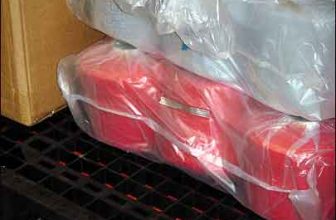
Smart logistics classic case: Nike’s top secret warehouse
[ad_1]
The ambitious local sporting goods brands Li Ning and Anta have always dreamed of surpassing Nike in the Chinese market, but Nike has added a new level of difficulty to this challenge. In early 2011, Nike China Logistics Center (CLC) opened in Taicang, Jiangsu, which is also its seventh and second largest logistics center in the world. When Nike’s annual sales in Greater China reached US$1.864 billion (fiscal report disclosed figures for the period from December 2009 to November 2010), what is its top priority and most important thing to do now? Not a brand, not a marketing. It is a powerful logistics support system that can efficiently manage inventory and fast replenishment.

The following figures are enough to make Li Ning and Anta envy. This giant square box has a construction area of 200,000 square meters, has more than 100,000 pallets, and has an annual handling capacity of more than 240 million pieces. It can also meet the loading and unloading of 79 container trucks. More importantly, Nike will take this to shorten the delivery time by 15%-a product from the store order to delivery will only take a few hours.
This is like a giant central processing unit. The basis of all commodity sorting and management relies on powerful digital collection and processing capabilities. All goods are embedded with electronic tags and scanned one by one. Workers sort and distribute the goods according to the information on the electronic display. The information is connected to Nike globally through a dedicated data port, and complete shared data is fed back to relevant departments every day. The vast amount of information is so much that the number of codes required by the computer is almost as much as that of Amazon, the world’s largest shopping site-this is a paradise where logistics experts turn their love for numbers and technology into results.
With a total of 9 kilometers of conveyor belts, sequential pickers, radio frequency scanners, automated warehouse management systems, and many other logistics technologies and equipment, this warehouse has reached the three indicators of distribution efficiency, throughput, and elasticity. The highest level in the world.
Smart world
This Nike’s first large-scale logistics center in China has two buildings, which store shoes and clothing goods respectively, and they are connected by a conveyor belt device. The storage area is divided into two major units, the FCL area and the pallet area, and the bulk pallet area is distributed between them. If a large order arrives, the FCL area can be directly delivered; small order replenishment can be directly drawn from the bulk goods in the pallet area. According to the distribution and sorting requirements, the clothing distribution floor is divided into three floors: the top floor has 45,000 shelves with independent codes, the second floor has two sets of automatic sorting systems, and the first floor is the packaging and loading distribution area.
Unexpectedly, the coding of the top shelf area with 45,000 independent codes is actually irregular. This is mainly to prevent the operator from memorizing the codes due to frequent operations, resulting in misoperation. The pick-up operator uses the machine voice system to talk to the computer to check the inventory information-the automatic control system will inform the operator of the pick-up area before picking up. After the operator arrives, he will report the shelf area code and pick-up to the computer system through a microphone and headset. The quantity is confirmed. This voice recognition system is independently developed by Nike. It can recognize languages of various countries, even dialects, and the system will collect and record the audio information of each operator in advance. As a precaution, Nike has also equipped an emergency device. Once the voice recognition system fails, the picker can use a handheld scanning device to help. This is another use of shelf coding.
At the same time, the angles of these shelves are designed in accordance with ergonomics, which minimizes employees’ lumbar muscle strain. Nike stipulates that when the shelves are abundant, the goods must first exist in the middle layer to facilitate the employees to pick up the goods. At the bottom of the shelf, the gap between the bottom shelf and the floor can accommodate the temporarily expanded shelf, which is convenient for storing materials during the peak delivery period.
The storage area on the top floor of CLC3 is as high as more than 10 meters. In order to maximize the space utilization rate and increase the cargo capacity, Nike adopted a narrow aisle system, and the width of the aisle between shelves is also reduced to the minimum, which is almost the same as the width of a forklift. Nike installed a special magnetic wire system for forklift traction under the floor. This set of intelligent guidance system allows the driver to enter the pick-up lane with the most accurate driving posture under the automatic guidance of the magnetic line of force, completely avoiding any collision. When automatically guiding the pick-up, the forklift can only go straight back and forth along the distribution of the magnetic wire, and will not swing from side to side; the pickup truck is loaded and the magnetic wire switch is turned off, and the truck can turn left and right.
The general process of CLC distribution and delivery of goods is: receiving an order, distinguishing the size of the order, and picking up the goods in the storage area. The whole box of order goods in the storage area is transported to the sorting area on the second floor through the conveyor belt. The operator and the conveyor belt will check and sort twice; the balance of the order goods will be manually replenished by the operator on the third floor, and the automatic sorter will inspect and load the goods. After the box is loaded, it will be transported to the first floor for scanning verification, loading and shipment.
In the operation process, the most critical element is accuracy. Taking clothing sorting as an example, when the entire box of goods in the storage area on the third floor is delivered to the second floor by the conveyor, the operator will scan the label with a handheld scanning device. There are strict regulations on the placement and height of all product labels to improve the efficiency of verification. After verification, when the conveyor belt is sent to the first floor, there are scanning devices every few meters along the way to scan the barcode of the packing box and record the location information. This information is connected to the automatic sorting equipment distributed in the functional areas of the logistics center, so that the products can be quickly transferred to different operation areas. Once the sorting is wrong, the transmission belt will automatically throw out the wrong goods and enter the special channel to be handled by someone.
When the goods are checked at various levels, from sorting to packaging, the CLC system will automatically print a label of goods, clearly indicating the goods number and number of pieces. The computer can also estimate the volume of the goods, and prompt the operator which type of packaging box is most suitable.
In addition to checking the number and code of the goods, the packing operator has another important task to put the shipping label of the goods to the specified position, so that the machine or manual inspection in the next link can be checked again. Before loading and dispatching, the warehouse management system conducts information screening again, and uses different vehicles and multi-level logistics networks according to the time distribution requirements of the order to ensure efficient, accurate, timely and lowest-cost delivery of products.
What to do if a fire occurs? CLC avoided all this at the beginning of the design. There are a total of more than 220 air detectors installed here. In the event of a fire, the automatic alarm system will respond and turn on the sprinkler system. Outside the storage area, Nike has also set up a “firewall”. Even if a fire occurs, the floor will only collapse in a specific direction to ensure that another independent area is safe and sound. In the center of the two walls, CLC has specially set up firefighters rescue channels and evacuation walkways. The latter also has a special positive pressure air supply system, which will only discharge smoke according to a specific air duct without harming personal safety.
[ad_2]




